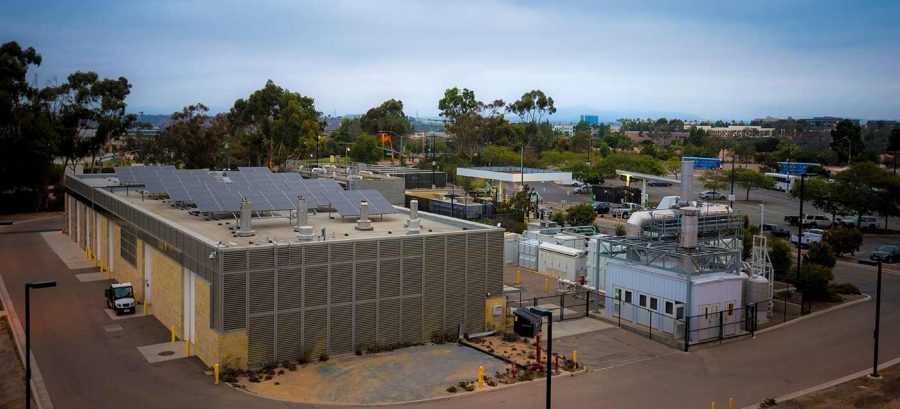“We fight disease, climate change, and systemic racism,” Chancellor Pradeep Khosla boasts about UC San Diego. In fact, sustainability is supposedly fabricated into the university’s DNA by the likes of Roger Revelle and Charles Keeling. But of course, this sustainability promise excludes the small fact that UCSD emits 300,000 tonnes of carbon every year through the methane-burning cogeneration plant ironically located in Revelle College.
The cogeneration plant is a 30-megawatt, natural-gas-fired combined heat and power system. It has been in use since 2001 and it is admittedly more efficient than other energy systems in its reduction of energy loss. The plant supplies 72% of the campus’s electricity needs annually, with the remainder of the electricity needs being imported from the local grid. But it’s also responsible for making UCSD the second-highest emitter of carbon emission among the 10 UC campuses, the first being UCLA.
Catherina Gere, the chair of the committee on campus climate change and a professor in the history department, talked to The UCSD Guardian about the original perks of the plant.
“The thinking then [in 2001] was that it was going to take decades and decades for the United States to transition away from making electricity using fossil fuels,” Gere said. “So the electrical grid was not going to be decarbonized in the near future. And so their calculation was that making electricity on-site, which is what the cogeneration plant does, using fossil gas was actually the most energy-efficient way to produce the energy for campus.”
Yet these original motivations don’t change the fact that the plant burns over $10 million worth of fracked methane every year. Methane, which is the main component of natural gas, is 80 times more powerful than carbon dioxide in warming the atmosphere.
“So the cogen plant has gas turbines which generate electricity and also gas boilers, which generates steam, which then creates hot water, chilled water, and electricity for campus,” fifth-year doctorate student Alexander Andriatis said. “So it’s a good system relative to 1990 standards. But the world has moved on and there’s a climate crisis and there are climate goals.”
Campus administrators are aware of the detrimental effects of the plant, yet they have been slow to take action, citing costs and lack of funding for the lack of progress.
Leslie Sepuka, associate director of university communications, told The Guardian the financial obstacles of decommissioning the plant in exchange for a fossil-free option:
“With the goal of reducing carbon emissions in mind, the university is exploring the feasibility of retiring the university’s natural-gas-fired cogeneration plant and converting to technologies that reduce the reliance on fossil fuel. Any conversion would require a plan, significant funding, and a commitment from all segments of the UC San Diego community,” she stated.
Yet funding does not seem to be an issue for other UCSD projects. The university recently celebrated the end of a decade-long Campaign for UC San Diego that raised $3.05 billion dollars. Moreover, UCSD just broke ground on its $365 million dollar project to build the two tallest residential towers in the University of California system.
With such extravagant spending, many feel frustrated that the university, despite its promising slogans of sustainability, has its priorities elsewhere. Fifth-year doctorate candidate Adam Cooper shared his perspective on the lack of action.
“Once the university commits to it, they’ll get it done pretty fast,” Cooper said. “Stanford committed to it. Six years later, they built two solar panels and they shut down their cogen plant and replaced it with electric pumps. Same thing happened to Arizona State and we’re seeing the same thing happen at Davis, and at Berkeley. So it really comes down to convincing leadership. I just don’t think the chancellor is prioritizing climate action on this campus and I don’t think he’s yet been convinced to be a leader in this regard.”
One key component in the university’s hesitancy to retire the plant — which is not advertised as explicitly — is the remaining balance on the mortgage UCSD received to build the cogeneration plant in the first place.
According to the UC San Diego Climate Action Plan published in 2019, the mortgage is planned to be paid off by 2032. The Guardian contacted campus administrators regarding the mortgage and if it could be paid in full earlier than expected, but administrators declined to comment.
Nevertheless, funding has been trickling in, not just through the university’s billion-dollar campaigns, but also by the state. In September 2022, UC President Michael V. Drake created a Fossil Free Pathways Task Force funded by money from the state to study and deliver plans to move away from fossil fuels on all UC campuses.
Adam Aron, co-founder of the UC Green New Deal coalition and professor in the psychology department, explained the celebratory but insufficient promise of the task force.
“It’s a big and amazing win, but it’s by no means over, because there’s a gap between making plans and actually doing anything,” Aron said. “Our worry is that they’ll make plans for years and years and years, like the city of San Diego made plans nine years ago and did nothing …We have this new campaign called ‘Khosla Must Commit.’ And we need him and we need the leadership at UCSD to not just make plans but to actually make commitments to get off the gas this decade.”
With plans yet to be made for the Fossil Free Pathways Task Force, there’s not much else to look forward to. And with the university’s great pride in its historical finding of the Keeling Curve, one of the first pieces of public evidence for linking global warming with the burning of fossil fuels, the expectations are set much higher. UCSD’s empty claims of sustainability fall short of the promise it set out to fulfill decades ago.
Photo Courtesy of Erik Jepsen














eva • Jan 23, 2023 at 12:38 pm
I earn more than $27,000 USD every month working part-time. I listened to several folks describe how much money they would fairly expect to make online, so it’s still tough to say. It all became genuine, and it dramatically changed my life. Everyone should now kb-40 try their hand at this field of business.
.
.
By accessing this website———————— >>> GOOGLE HOME JOBS